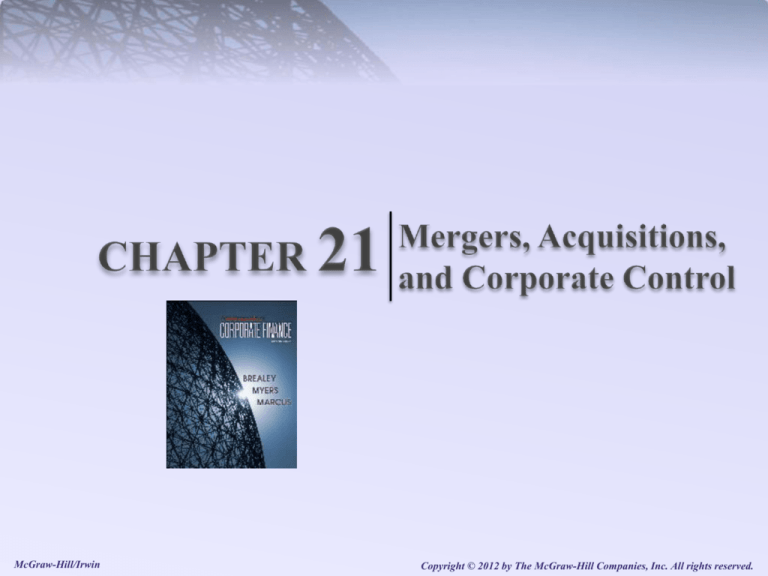
McGraw-Hill/Irwin
Copyright © 2012 by The McGraw-Hill Companies, Inc. All rights reserved.
Mergers, Acquisitions and
Corporate Control
The Number of Mergers in the United States
(1962-2009)
21-2
Types of Mergers
Horizontal Merger
A merger between two firms in the same line of business
(former competitors)
Vertical Merger
A merger between companies at different stages of
production
Conglomerate Merger
A merger between companies in unrelated lines of business
21-3
Sensible Reasons for Mergers
Economies of Scale
Economies of Vertical Integration
Combining Complementary Resources
Mergers as a Use for Surplus Funds
21-4
Economies of Scale
With economies of scale, a larger firm may be
able to reduce its per unit cost.
How?
21-5
Economies of Vertical
Integration
Control over suppliers “may” reduce costs.
Over-integration can cause the opposite effect.
Pre-integration
(less efficient)
Post-integration
(more efficient)
Company
Company
S
S
S
S
S
S
S
S
21-6
Combining Complementary
Resources
Merging may result in each firm filling in the “missing pieces”
of their firm with pieces from the other firm.
Firm A
Firm B
Example: A small firm may have a valuable patent, but lack the engineering and
sales organization necessary to produce and market it on a large scale. It could be
acquired by a larger firm with those capacities already in place.
21-7
Use for Surplus Funds
If your firm is in a mature industry with few, if any,
positive NPV projects available, acquisition may be
the best use of your funds.
What might this imply about the pre- and postacquisition PVGO?
21-8
Dubious Reasons for Mergers
Diversification
The Bootstrap Game
21-9
Diversification
Diversification
Investors should not pay a premium for
diversification since they can do it themselves.
21-10
The Bootstrap Game
Acquiring Firm has high P/E ratio
Selling firm has low P/E ratio (due to low
number of shares)
After merger, acquiring firm has short term
EPS rise
Long term, acquirer will have slower than
normal EPS growth due to share dilution.
21-11
The Bootstrap Game: Example
World Enterprises
(before merger)
EPS
Price per share
P/E Ratio
Number of shares
Total earnings
Total market value
$2.00
$40.00
20
100,000
$200,000
$4,000,000
Current earnings
per dollar invested
in stock
$0.05
World Enterprises
(after buying Muck
and Slurry)
Muck and Slurry
$2.00
$2.67
$20.00
$40.00
10
15
100,000
150,000
$200,000
$400,000
$2,000,000
$6,000,000
$0.10
$0.067
21-12
The Form of the Acquisition
Merger – When the acquiring firm buys all the assets and
all the liabilities of the other firm and combines them into
one firm
Tender Offer – The acquiring firm buys all the stock of
the target firm
Asset Purchase – When the acquiring firm buys only the
assets of the target. The target continues to exist as firm with
cash instead of assets
21-13
Evaluating Mergers
Ask:
Is there an overall economic gain to the merger?
Do the terms of the merger make the company
and its shareholders better off?
PV ( A B) PV ( A) PV ( B)
Synergy
21-14
Financing Mergers
Mergers Financed by Cash
Mergers Financed by Stock
21-15
Evaluating Mergers
Economic Gain = PV(increased earnings)
=
New cash flows from synergies
discount rate
21-16
Evaluating Mergers: Example
Given a 20% cost of funds, what is the economic gain, if any, of
the merger listed below? (GenPharm acquires Biotex)
GenPharm Biotex Combined Company
Revenues
200
25
225
(+0)
Operating Costs
110
17
120
(- 7)
Earnings
90
8
105
(+7)
Economic Gain=
7
$35
.20
Which of the “sensible reasons” for a merger is this merger
most likely based on?
21-17
The Market for Corporate
Control
1.
2.
3.
4.
Proxy Contests
Takeovers
Leveraged Buyouts
Divestures, Spin-Offs or Carve-Outs
21-18
Proxy Contests
Proxy
The right to vote another shareholder’s shares
Proxy Contests
Takeover attempt in which outsiders compete with
management for shareholders’ votes
Proxy Access (2010)
Problem with Proxy Contests?
21-19
Takeovers
Tender Offer: a direct offer of purchase to
current shareholders, without consulting with
management
How can management react to a tender
offer?
21-20
Takeover Defensive Tactics
White Knight
Shark Repellent
Poison Pill
21-21
Leveraged Buy-Outs (LBO)
Large portion of buy-out
financed by debt
Shares of the LBO no longer
trade on the open market
Leveraged Buyout vs. Management Buyout
21-22
Potential Gains from an LBO
Junk bond market
Leverage and taxes
Other stakeholders
Leverage and incentives
Free cash flow
21-23
Divestitures, Spin-Offs, and Carve-Outs
Divestiture
When a firm sells some of the assets to another entity as
a going concern
Spin-Off
The process of a business separating the ongoing
operations of a unit of that business and giving the
shareholders of the parent firm shares of the unit
Carve-Outs
Similar to a spin-off, but issues shares of the new firm to
the public
21-24
Benefits and Cost of Mergers
Who usually benefits from a merger?
Who usually loses in a merger?
21-25









